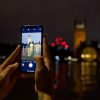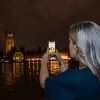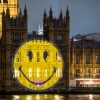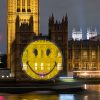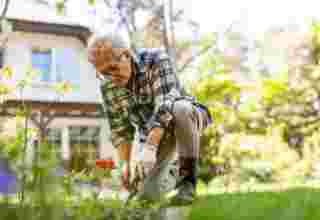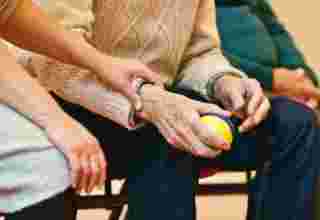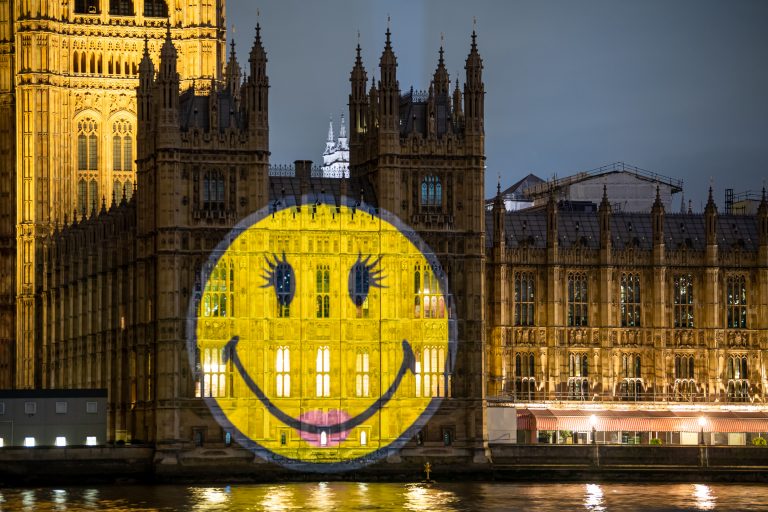
These eye-catching images of a smiley face were projected onto the Houses of Parliament to spread an uplifting message of positivity.
A smile – especially one which is 25 meters wide – can go a long way to cheering people up, which is more important than ever at the moment.
The lipstick-wearing smiley was beamed onto the famous structure last night, the eve of World Emoji Day, by Ciaté London to remind people of the importance of a smile.
The positive image reminded passers-by to stay upbeat and to spread an uplifting message.
Passers-by who saw the images last night said it had brightened up their evening considerably.
Dave Crawford said: “Seeing the smiley made me laugh. It’s also opposite a hospital, and you hope that people get to look out and see it – they probably need it.
“Hopefully it will make them smile – we need more smiles right now.
“It’s hard to know if people are smiling behind masks these days.”
Another onlooker, Kate Sandison, added: “I try and smile, but you do forget, especially in London.
“The projection really surprised me, it looks great and makes you feel good. It made me smile.”
The projection came after research also commissioned by Ciaté London found British adults smile 11 times a day – a total of 252,945 over the course of their lifetime.
Charlotte Knight, founder and CEO, of Ciaté London said: “It’s World Emoji Day and what better way to celebrate the influence and revolutionary power that Smileys have had on our lives then dropping a new range of icons, created in partnership with the originators of the concept.
“These new icons feature lashes and lipstick as part of our mood-boosting new beauty line with SmileyWorld.
“The research proved how often people enjoy smiling and the difference it can make to both self-confidence and overall moods.
“Particularly at times like this it’s important to stay self-confident, emotionally aware and see the positives in everyday moments by sharing smiles.”
The research of 2,000 adults also found more than two thirds of respondents use their facial expressions to reflect their mood.
As well as smiling, adults frown eight times a day and pout twice – amounting to 183,960 frowns over a lifetime and 45,990 pouts.
But more than a quarter believe they have smiled more with age and 36 per cent are most likely to keep their lips closed when doing so, while 28 per cent will show teeth.
Almost half of those polled have had their smile complimented on, despite 46 per cent having felt conscious about their grin at some point.
It also emerged that in order to boost their confidence and make them smile, 22 per cent have worn makeup, a fifth have changed their hairstyle and 12 per cent have put on bright coloured clothing.
Similarly, 30 per cent of women said lipstick helps them feel more confident, while 49 per cent feel the same way about mascara and 33 per cent get a boost from wearing perfume.
Red lipstick has stood the test of time, with it being revealed as the most confidence-inducing shade, followed by nude and light pink.
One in six even claimed they couldn’t imagine leaving the house without any lippy on, while 17 per cent wouldn’t do so without wearing foundation.
The study also revealed the top things to trigger a smile, including getting positive news (53 per cent), hearing a joke (47 per cent) and being with family (46 per cent).
Other moments which make you beam included getting a compliment from a stranger (41 per cent), payday (26 per cent) and eating a nice meal (38 per cent).
And in recent months during the pandemic, 45 per cent believe it’s been important to find things to smile about in order to stay positive.
Similarly, a third of those polled via OnePoll want to find more things to beam about following lockdown and 28 per cent vow to have more of a positive outlook in the future.
More than half also said seeing someone else look happy improves their mood and in recent months 28 per cent have made more of an effort to smile at others.
jQuery(document).ready(function($) {
// We only want these styles applied when javascript is enabled
$(‘.gal_content’).css(‘display’, ‘block’);
// Initialize Advanced Galleriffic Gallery
var gallery = $(‘#thumbs_40335_1’).galleriffic({
delay: 3500,
numThumbs: 12,
preloadAhead: 12,
enableTopPager: false,
enableBottomPager: false,
imageContainerSel: ‘#slideshow_40335_1’,
controlsContainerSel: ‘#controls_40335_1’,
captionContainerSel: ‘#caption_40335_1’,
loadingContainerSel: ‘#loading_40335_1’,
renderSSControls: true,
renderNavControls: false,
playLinkText: ‘Play Slideshow’,
pauseLinkText: ‘Pause Slideshow’,
enableHistory: 0,
autoStart: 0,
enableKeyboardNavigation: true,
syncTransitions: false,
defaultTransitionDuration: 300,
onTransitionOut: function(slide, caption, isSync, callback) {
slide.fadeTo(this.getDefaultTransitionDuration(isSync), 0.0, callback);
caption.fadeTo(this.getDefaultTransitionDuration(isSync), 0.0);
},
onTransitionIn: function(slide, caption, isSync) {
var duration = this.getDefaultTransitionDuration(isSync);
slide.fadeTo(duration, 1.0);
// Position the caption at the bottom of the image and set its opacity
var slideImage = slide.find(‘img’);
caption.fadeTo(duration, 1.0);
},
onPageTransitionOut: function(callback) {
//this.hide();
setTimeout(callback, 100); // wait a bit
},
onPageTransitionIn: function() {
var prevPageLink = this.find(‘a.prev’).css({‘opacity’: ‘0.3’ , ‘display’ : ‘inline-block’, ‘cursor’ : ‘default’});
var nextPageLink = this.find(‘a.next’).css({‘opacity’: ‘0.3’ , ‘display’ : ‘inline-block’, ‘cursor’ : ‘default’});
// Show appropriate next / prev page links
if (this.displayedPage > 0)
prevPageLink.css({‘opacity’ : ‘1’ , ‘display’ : ‘inline-block’, ‘cursor’ : ‘pointer’});
var lastPage = this.getNumPages() – 1;
if (this.displayedPage < lastPage)
nextPageLink.css({'opacity' : '1' , 'display' : 'inline-block', 'cursor' : 'pointer'});
this.fadeTo('fast', 1.0);
}
});
/**************** Event handlers for custom next / prev page links **********************/
gallery.find('a.prev').click(function(e) {
gallery.previousPage();
e.preventDefault();
});
gallery.find('a.next').click(function(e) {
gallery.nextPage();
e.preventDefault();
});
});
ENDS


